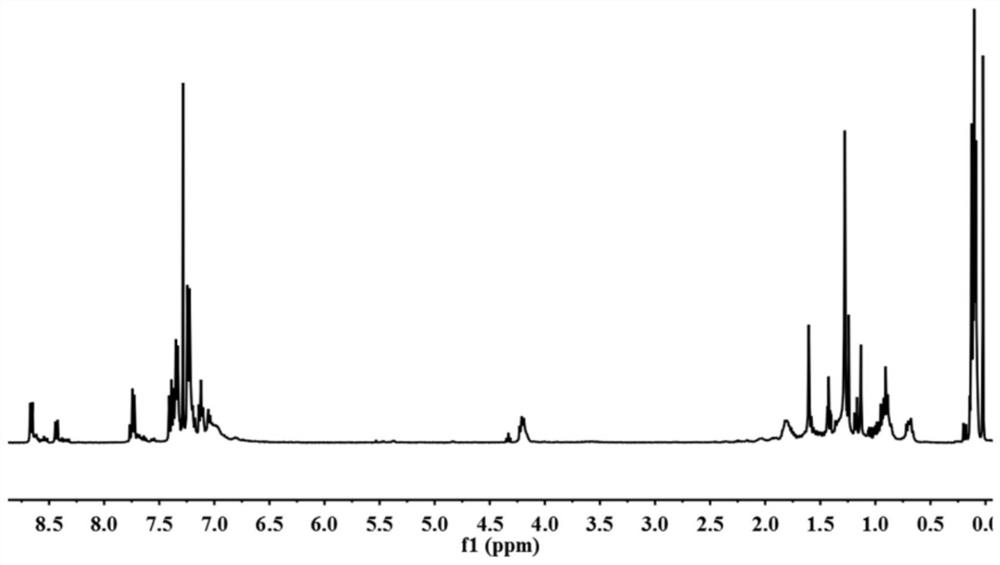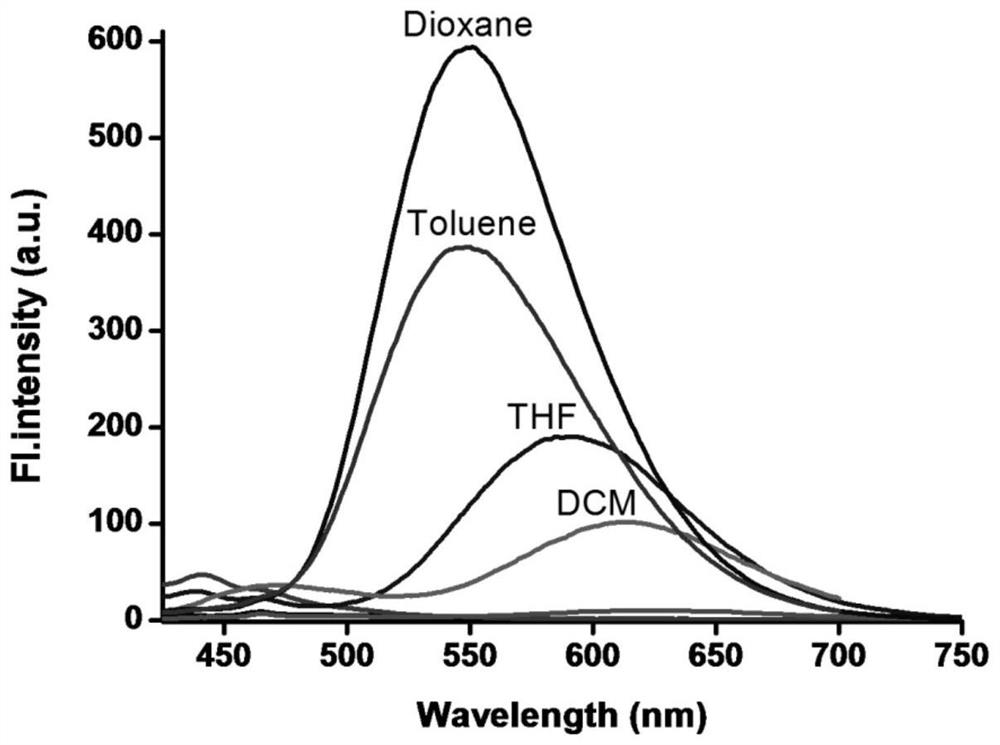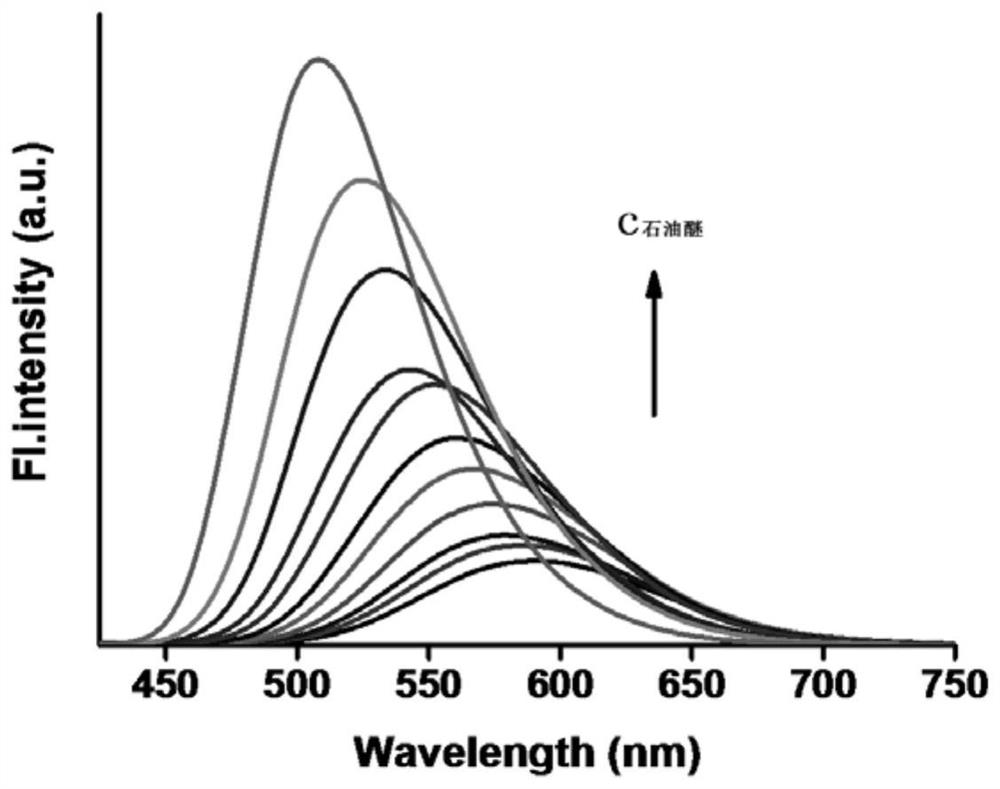A Silicone Fluorescent Probe for Detecting Lipid Droplets
A fluorescent probe and silicone technology, applied in the field of analytical chemistry, can solve the problems of high biotoxicity of probes, poor cell membrane penetration ability, low sensitivity and effect effects, etc.
- Summary
- Abstract
- Description
- Claims
- Application Information
AI Technical Summary
Problems solved by technology
Method used
Image
Examples
Embodiment 1
[0029] Synthesis of embodiment 1 fluorescent probe
[0030] (1) Dissolve 2 g of aminopropyl silicone oil in 20 mL of ethanol, then dissolve 0.4 g of 4-bromo-1,8-naphthalene anhydride in 40 mL of ethanol, and add them together to a 100 mL eggplant-shaped reaction flask In the middle, the temperature was raised to 80°C, and the reaction was refluxed for 8h. After the reaction, the solid was obtained by filtration, purified by column chromatography (methanol:dichloro=1:20), and compound 1 was obtained after drying;
[0031] (2) Dissolve 0.37 g of compound A in 20 mL of toluene, and then dissolve 0.346 g of triphenylamine 4-borate in 20 mL of toluene, and add them together into a 100 mL eggplant-shaped reaction flask. Then add 0.058 g of tetrakis(triphenylphosphine)palladium, 2mL of K 2 CO 3 aqueous solution (2 mol / L). Under nitrogen protection, the reaction was stirred at 80°C for 10 h. After the reaction, it was purified by column chromatography (methanol:dichloro=1:10), an...
Embodiment 2
[0032] Fluorescence spectra of embodiment 2 fluorescent probes in solvents of different polarities
[0033] Prepare 10 mL of the polymer fluorescent probe TR mother solution for detecting polarity according to the present invention with a concentration of 1 mM as a spare. Add 20 μL probe master solution to 2 mL solvents of different polarities (probe concentration is 10 μM). The solvents are listed in descending order of polarity: toluene, dichloro, tetrahydrofuran, 1,4-dioxane, acetonitrile, DMF, DMSO. The excitation wavelength is 405 nm. The result is as figure 2 Shown: The maximum emission peak of probe TR gradually red-shifted with the increase of solvent polarity.
Embodiment 3
[0034] Embodiment 3 Fluorescence spectra of fluorescent probes in different ratios of petroleum ether and tetrahydrofuran
[0035] Prepare 10 mL of the polymer fluorescent probe TR mother solution for detecting polarity according to the present invention with a concentration of 1 mM as a spare. Prepare 2 mL of mixed solvents of petroleum ether and tetrahydrofuran in different proportions, petroleum ether: tetrahydrofuran = 0, 10%, 20%, 30%, 40%, 50%, 60%, 70%, 80%, 90%, 95% . Add 10 μL of the mother solution into 2 mL of different polar solvents to test the fluorescence spectrum, the excitation wavelength is 405 nm, the results are as follows image 3 Shown: With the increase of petroleum ether volume content in the volume, the fluorescence intensity increases gradually. This is because the solubility of the probe in petroleum ether is very poor. Increasing the percentage of petroleum ether in the solvent is equivalent to making the probe TR aggregate and increase the intens...
PUM
 Login to view more
Login to view more Abstract
Description
Claims
Application Information
 Login to view more
Login to view more - R&D Engineer
- R&D Manager
- IP Professional
- Industry Leading Data Capabilities
- Powerful AI technology
- Patent DNA Extraction
Browse by: Latest US Patents, China's latest patents, Technical Efficacy Thesaurus, Application Domain, Technology Topic.
© 2024 PatSnap. All rights reserved.Legal|Privacy policy|Modern Slavery Act Transparency Statement|Sitemap



